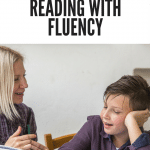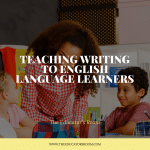 On Friday mornings, the lights would go off, quietly chatting, the class moved to the rug. Each child held a book of poems. They sat in a circle, poems on the floor in front of them. I would ask a student to start. As he began to read, the child next to him picked up her poem. The rest of us listened, heads cocked, eyes on the reader or unfocused, hands still. When the poem was over, we snapped our fingers in admiration. Then the process repeated until everyone, even the children who could barely read, read the poem they had selected and practiced. With 26 kids, the whole process took about fifteen minutes. Afterwards, poetry books were put back in the library until Monday, when new poems were picked and we began again. My class was always eager to do this and complained loudly if we had to skip a week.
On Friday mornings, the lights would go off, quietly chatting, the class moved to the rug. Each child held a book of poems. They sat in a circle, poems on the floor in front of them. I would ask a student to start. As he began to read, the child next to him picked up her poem. The rest of us listened, heads cocked, eyes on the reader or unfocused, hands still. When the poem was over, we snapped our fingers in admiration. Then the process repeated until everyone, even the children who could barely read, read the poem they had selected and practiced. With 26 kids, the whole process took about fifteen minutes. Afterwards, poetry books were put back in the library until Monday, when new poems were picked and we began again. My class was always eager to do this and complained loudly if we had to skip a week.
I shared poetry whenever possible, reading or reciting poems to my second grade class. I love the way the images and emotions are stuffed into a tight package of words. I would often pick up a book of poems and read a favorite. This wasn’t simply for my own joy. Learning to read poetry well is a fantastic reading instruction tool. It covers all the basics: fluency, vocabulary, word work, and comprehension. It was part of the fabric of my language arts teaching. Here is how you can accomplish this. It would work for any grade level.
1. Build a collection of poetry. If you have books of poetry, put them all in one place and build upon it. Look for poetry with a variety of interests and difficulty. Be sure to include nursery rhymes collections and jump rope verses. I bought poetry books at the used bookstore. I tore up old, falling-apart poetry books. I tore poems from out-of-date reading texts from a variety of grade levels which were stored in the book room for decades. I tore poems out of those teaching hand-outs or guides I never used. These were glued onto notebook paper or slid into plastic sleeves. I inserted ten or twelve of them into a folder with clips and wrote “POEMS” on the front. The folders were added to the poetry section of the classroom library. This expanded my collection so that there were plenty of “books” to choose from. I tried to have more collections of poems, whether it was book or folder, than students in the class.
2. Teach the students to select an appropriate poem. This took time at the beginning of the year but it paid off in spades. On Monday, the class would begin perusing the poetry books. In September, I would put a stack of poetry books on each table, limiting the selection. As the year went on, the class began to know what poetry collections appealed to them. In selecting a poem, students had specific things to look for. As they would be reading in front of the class, they were motivated to do it well. My struggling readers or my students who had trouble deciding sat with me to go through poems. These are the things that needed to be thought about:
Difficulty: the poems should only have two or three words that challenged them. They could be words they didn’t recognize or understand.
Length: Poems that were too long could be a problem in a poetry slam for second graders. My general rule was 16 lines unless the reader could convince me otherwise.
Interest: The poem had to be compelling to the student. If they didn’t get enjoyment from it, they would not be successful reading it to the class.
3. Practice each day. Students needed to read their poem twice each day to a partner. This only takes a minute or two. Partners had the job of making sure all the words were known and their friend comprehended the meaning of the poem, at least superficially. They could check with an adult on how to pronounce words or check for meaning. They also checked that the pacing was neither too fast nor too slow. This was a skill that my struggling readers accomplished better than my secure reader. It was always a chore to make those confident readers understand that fast does not equal good when reading poetry. I know some teachers use Audacity where a child can read their poem and then listen to it. Anyway you do it, practice, practice, practice. Practice is key to this as familiarity with vocabulary and comprehension of material supports accuracy and prosody.
4. Grade for fluency. Thirty percent of my reading grade was based on fluency. Three times a marking period I gave a grade for fluency using the poetry slam. This in addition to a standardized fluency assessment given each quarter. I felt the poetry reading gave a more accurate picture of true fluency, reading material with appropriate expression, pace, and prosody. Here is a link to a rubric that is similar to the one I used
My class grew to love poetry. I laughed with them at poetry by Shel Silverstein or Bruce Lansky. I secretly dried tears when they read beautiful poetry by Mattie J. T. Stepanek. Eventually, we wrote our own poetry and added that to our poetry collection. My students’ selections were frequently surprising. A tough boy picking poems about flowers in the springtime or a quiet girl reading “I Am Boom!” by Jack Prelutsky became the norm. An average reader once dramatically read “Amphisbaena” by Myra Cohn Livingstone. I was so skeptical when he selected the poem. He had been determined, however, and nailed it. I once gasped out loud when a brilliant boy who never got in trouble read a poem where the word “fart” was repeated thirteen times.
My students became aware of what reading should sound like, both aloud and in their heads. Checking for understanding, using inflection and building confidence gave them all a sense of accomplishment which led to becoming better readers.[/fusion_builder_column][/fusion_builder_row][/fusion_builder_container]





